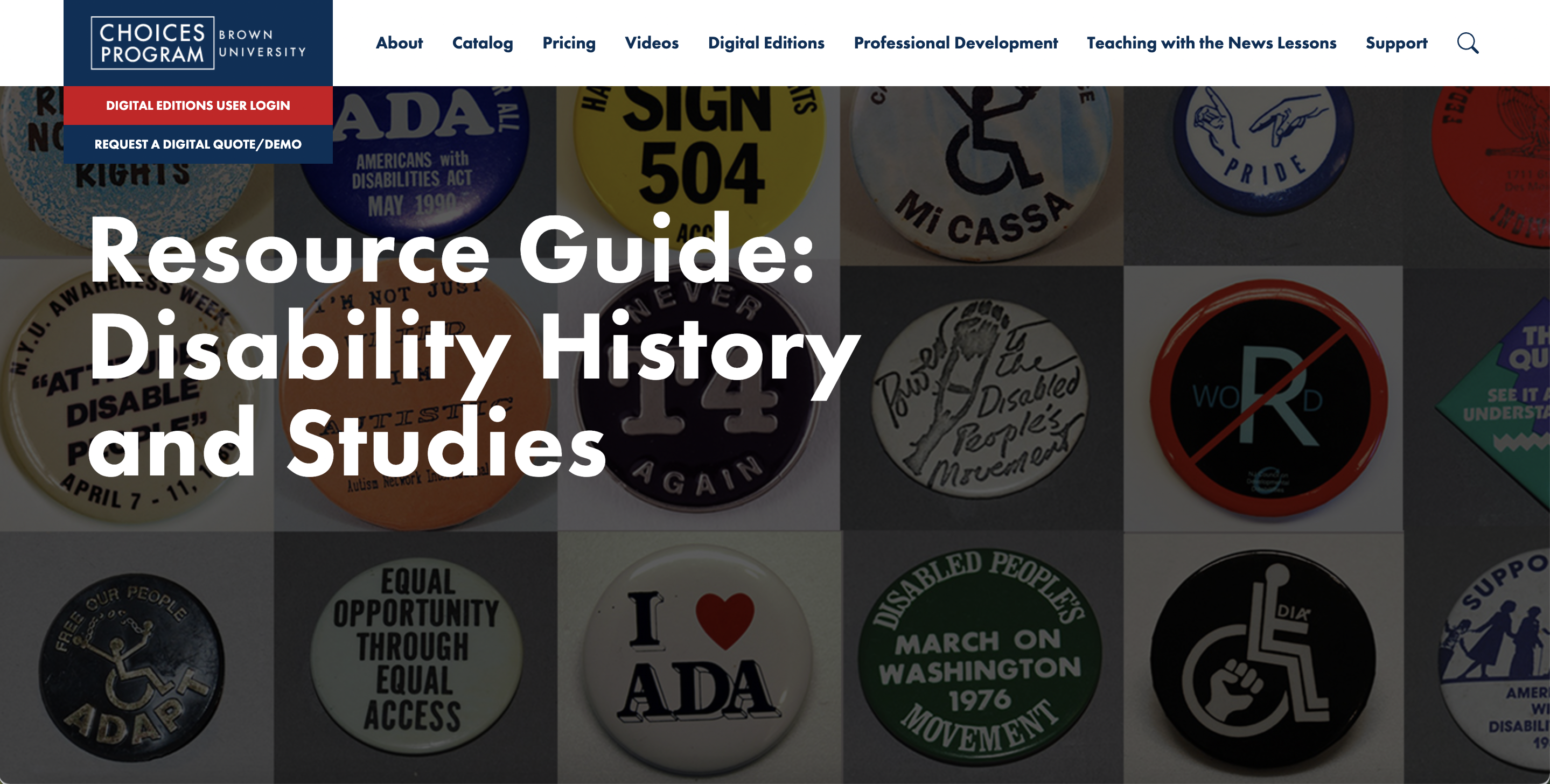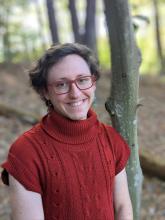Update: August 4, 2025 - After 30 years, on June 30 Brown University abruptly shut down the Choices Program and all its curriculum and resources.
Guest post by Max Chervin Bridge
Choices Program, a non-profit, secondary education initiative from Brown University’s Department of History, recently published a free online Resource Guide on Disability History and Studies. Choices’ resource guide collects a diverse array of lesson plans, online blogs, academic essays, virtual exhibits, podcasts, short documentaries, and more that point educators to some of the core ideas informing the work of disability history and studies, contemporary disability activism, and anti-ableist pedagogy.
Choices’ guide emphasizes that disabled students deserve to see people like themselves in school curricula and to play some role in shaping that curricula—all within a learning environment responsive to their and their classmates’ access needs. Three central ideas undergird the resource guide: 1) disability history is inseparable from contemporary questions of disability justice and the lived experiences of disabled people today; 2) the importance of studying the intersections between disability and other kinds of social and political identity, including race, gender, sexuality, and Indigeneity; and 3) the belief that disability history is integral to all history, as humans across time and place have experienced and thought about the meanings and implications of bodily difference, diversity, and change.
In what follows, Max Chervin Bridge, lead author of Choices’ resource guide and a Ph.D. candidate in Brown’s Department of History, introduces some of the resources collected in the guide and explains Choices’ objectives in including them.
“Access” to disability history and studies curriculum is our starting point—an orientation drawn from (among others) the work of Sara Barber-Just, a teacher at Amherst Regional High School (MA) who develops disability studies curricula. Barber-Just approaches disability studies as firstly a question of pedagogy, working to integrate universal design principles, assignment scaffolding, and practices of access intimacy across the curricula and throughout the classroom. We include Barber-Just's interview with Crip News to foreground how anti-ableist pedagogy, disability justice, and disability history and studies are interlinked. Introducing disability-centric topics—not only in disability studies courses, but across curricula—provides meaningful representation for disabled and neurodivergent students. These topics are best explored in conversation with students’ experiences in their own lives.
Choices’ resource guide also focuses on a long-held central premise of disability history: that “disability” is not just an identity, but a category of analysis like gender, race, or class that has much to say about larger historical developments. The guide includes Douglas Baynton’s classic writing about how political ideas in the United States about civic competence revolved around categories of mental and physical disability and capacity (themes he has continued to explore in his work on histories of immigration and eugenics). Relatedly, Beth Linker’s short essay explores how we define and describe “ableness”—as much as how we define and describe “disability”—has evolved over time, as different kinds of bodies and minds have been valued differently within different historical contexts.
Choices’ guide especially emphasizes the intersections of disability history and identity with other historical forms of marginalization and other social identities. Many of the resources linked to in the guide foreground these intersections. For example, Talila A. Lewis, in conversation with Dustin Gibson and other disabled Black and racialized collaborators, has developed a “working definition” of “ableism” sensitive to overlaps across many forms of marginalization. Likewise, Cherokee writer Jen Deerinwater’s essay demands attention to the particular vulnerabilities faced by disabled, Deaf, and ill Indigenous people in the face of climate change and resource extraction in North America.
A final core tenet of Choices’ approach to the resource guide is that “doing disability history” is fundamentally a political practice that prioritizes finding, recovering, and amplifying voices that have been marginalized in both the past and present. As disability justice activist Mia Mingus insists in her blog, Leaving Evidence: “we must leave evidence, evidence that we were here, that we existed, that we survived and loved and ached.” The resource guide includes multiple digital archives created and maintained by disabled people and disability-centered organizations—such as the Covid Disability Archive—in order to highlight this political and historical reality.
As part of a recent collection of essays entitled What is History Now?, deaf historian Jaipreet Virdi asks, “How Can We Tell the History of Disability?”:
"Disability has always been central to our lives. From debates about qualifications for democratic citizenship, to the ravages of war-scarred bodies, improvements in medical technologies, and controversies and access and accommodation, people have grappled with issues of disability in both their personal lives and in the public arena…. [T]he people whose histories have long been glossed over, trapped in medical files or valued only for inspiration, need their stories to be told."
Choices Program’s resource guide was made in the hopes of helping to tell these stories in ways that are as grounded in the past as they are responsive to the present.
Choices Program develops secondary education curricula on U.S. history, world history, and contemporary international relations, and offers workshops, institutes, webinars, and other professional development programs for educators. Max Chervin Bridge, a curriculum consultant at Choices and Ph.D. candidate in Brown University’s Department of History, is writing their dissertation on the history of ocean environments, sound, and whales, and is currently planning to teach a course on environmental histories of disability in the United States.





